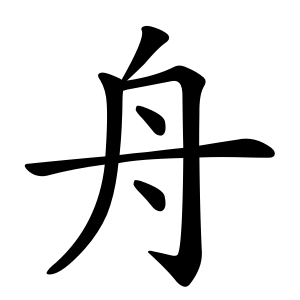舟
- boat, ship;
It representing the transportation vessel known as a "boat."
Etymology
舟 (배 주) is a pictograph representing a boat made by cutting and shaping wood. Since the Han dynasty, the character船 (배 선) has been widely used in China to denote boats in general, while 舟 came to mainly signify smaller boats.
In Korea and Japan, the stroke under the horizontal line in 舟 is written straight, whereas in China, it is written as a dot-like stroke similar to the stroke above the horizontal line.
Additionally, some characters incorporate 舟 in a form that resembles 月 (moon), such as 兪 (성 유), 前 (앞 전), and 服 (옷 복). According to the 설문해자, 朝 (아침 조) was once represented as a combination of 倝 (아침해 빛날 간) and 舟, but in the example script (예서), it reverted to its original form.
Usage in Korean
When used as a radical, 舟 typically conveys meanings related to the boat itself, tools used on boats, or navigation and sailing.
An exception to this is the character 般 (일반 반), which uses the 舟 radical but does not directly relate to boats or sailing.
Alternative forms
In Chinese, the stroke at the bottom is written as a dot, ㇔.
In Japanese, Korean, and Vietnamese, the stroke at the bottom is written as a line, ㇑, as found in the Kangxi dictionary.
Characters with 舟
- 竹月卜戈 (HBYI)
- ⿻ 𠔾 ⺀
- ⿻ 𠔾 ⿱ 丶 丨
